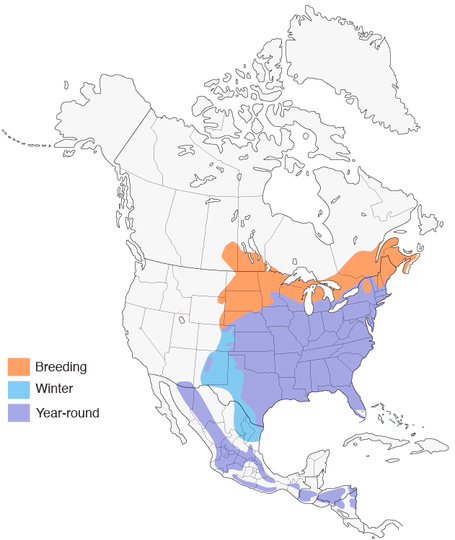Bluebird Information
Eastern Bluebird (Sialia sialis)
- The Eastern Bluebird is a member of the thrush family, as is the robin.
- Adult males are a dark blue color on their head, back, wings and tail. They are a reddish-brown color on their chin and breast. Their belly is white.
- Adult females are a duller blueish-gray color on the head, dull brown on their back and blue on the tail and wings. They are a light reddish-brown on the chin and breast. Their belly is white.
- The Eastern Bluebird is found throughout the Eastern U.S. and Southern Canada.
- Eastern Bluebirds in the north will remain as far north during the winter as they can as long as they can find food, water and shelter. The harder the winter, or the more scarce food, water and shelter are, the further south they will migrate until winter breaks.
- Eastern Bluebirds generally return north to the State of New York in early to mid-March.

Habitat
Bluebirds live in open fields, woodlands, farmlands, or orchards with little understory and sparse ground cover. They do not generally nest in cities or suburbs but can be found in parks, cemeteries, and golf courses.
Diet
Bluebirds are insectivores (eat insects) much of the year, and catch their food on the ground. Their main prey are caterpillars, grasshoppers, and spiders. In the fall and winter, they eat fruits from native plants such as sumac, dogwood berries, pokeweed, and juniper berries.
Behavior
Bluebirds sit on high branches and telephone lines to hunt for prey on the ground below. They will also hover over the ground, rapidly fluttering their wings, looking for food.
Nesting
Bluebirds nest in cavities and look for trees with natural cavities. They typically prefer a snug nesting cavity created by woodpeckers in dead pine or oak trees, but will also nest in artificial refuges like nest boxes with similar dimensions.
Nesting season begins in spring, and bluebirds typically have more than one successful brood per nesting season.
Average Activity Periods
Many of these periods are subject to delay or extension due to inclement weather and food availability.
- Courtship: 3 to 5 days
- Nest building: 4 to 5 days by the
- Egg Laying: 1 or 2 days after completion of nest. One egg is laid each day until the clutch is completed.
- Clutch Size: 4-6 eggs. Eggs are clear blue or occasionally white.
- Incubation: performed by females only, starts when the last egg is laid and lasts on average around 14 days.
- Hatching Young: naked, closed eyes, clumsy, dependent on food from parents
- Brooding: starts after eggs hatch and lasts for the first few days, keeping the birds warm until they have developed feathers and can regulate their body temperature.
- Fledging: occurs around 18 days old.
Competing Species
Tree Swallows, Black-capped Chickadees, and House Wrens are native birds that will compete for bluebird nesting cavities.
House Sparrows are an invasive species that will compete with native cavity-nesting birds and kill the occupants.
Predators
Raccoons, snakes, raptors, and feral/stray cats are the primary predators of bluebirds. Squirrels and chipmunks will also prey on their eggs and young.
How can we help?
We can aid the Eastern Bluebird’s success by investing in proper nest boxes and installing them in areas similar to their natural habitat, monitoring them regularly, deterring predators and invasive species, and providing supplemental food at feeding stations and native landscaping.
Why help the bluebird?
Since bluebirds eat insects, they keep down pest populations and make the environment more tolerable for humans. Their populations offer increased diversity to the animal kingdom, making them healthier. Their unique appearance and behavior offer beauty to the world.
